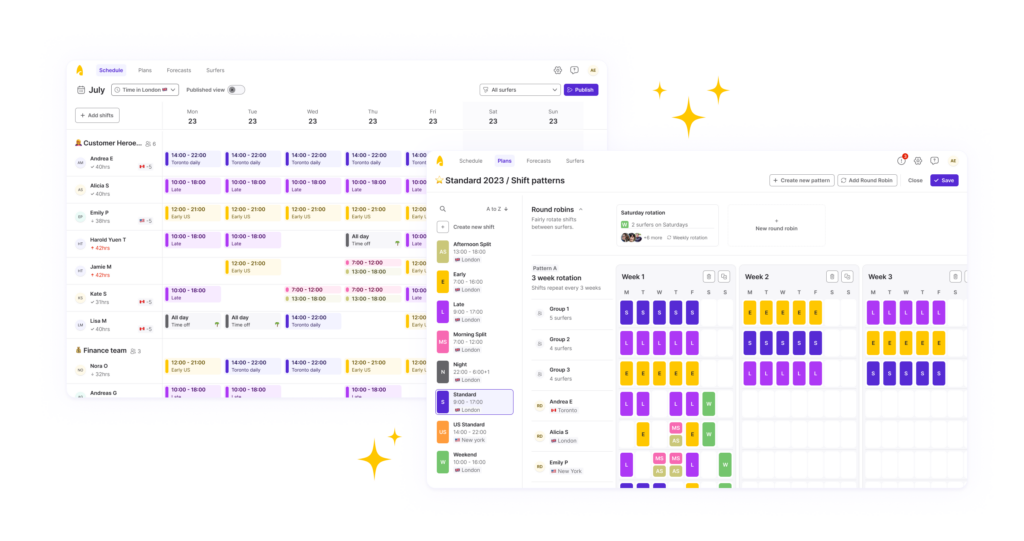
What is shift planning? 4 must-know best practices

Shift planning is not a new phenomenon, but how it’s done is changing rapidly.
With the rise of remote working and geographically distributed teams, shift planning has become much more than defining shift rotations with pen and paper or on spreadsheets. It’s becoming more human-centric, with employees within teams having much more of a say as to what their schedule looks like.
For modern teams, shift planning can be crucial, depending on their industry or customer type.
Learn what exactly shift planning is and how to get started with it. We’ve also outlined 4 best practices for implementing shift planning.
What is shift planning?
Shift planning is the process of defining a schedule that dictates what hours need to be worked by who over a specific period of time. It also includes shift overlap, shift change times, vacation, training, holidays, and time zones.
Here is an example how shift planning looks like in Surfboard:

Usually, shift planning is carried out with a few weeks’ notice, allowing for short-term scheduling. On the other hand, long-term requirements planning can be undertaken months or even years ahead of time.
In non-emergency call centres, staggered shifts are also implemented. Here’s an example of a slide shift call centre – the first shift could span from 7 am to 2 pm, followed by the second shift from 8 am to 3 pm, and the third shift from 11 am to 4 pm, and so forth.
A common example of a shift plan could be:
- From 7 am – 8 am, there are five employees answering phones.
- At 8 am, 12 more people come on duty.
- At 12 am, 12 more come in, and a few others leave. At 3 pm, 11 go home.
The objective of shift planning is to minimise overall costs and enhance work efficiency. The scheduling problem has three aspects:
- an objective to minimise the costs of the schedule (for example, by minimising total employee hours);
- decisions, what are the shifts of the employees;
- constraints must be satisfied, the staffing requirements and the scheduling rules.
Outcomes of poor shift planning
Failing to develop proper shift planning may result in the following.
- Low employee satisfaction
Poor shift planning leads to dissatisfaction among employees. If shifts are assigned without considering employees’ preferences, availability, or work-life balance, it can result in frustration and demotivation. This can harm morale, productivity, and overall job satisfaction.
- Inefficient workflows
Inadequate shift planning can disrupt efficient workflows within an organisation. If shifts are not properly scheduled or coordinated, it can lead to employee conflicts, such as overlapping responsibilities or insufficient staffing during busy periods. This can hamper productivity, increase errors, and decrease retention rates as disgruntled employees may seek better working conditions elsewhere.
- Mental health issues
Poor shift planning can have detrimental effects on employees’ mental health. Constantly changing schedules, irregular working hours, or long shifts without adequate breaks can disrupt sleep patterns, create stress, and affect work-life balance. These factors can contribute to increased anxiety, fatigue, and burnout among employees, negatively impacting their mental well-being.
- Increased costs
Inefficient shift planning can lead to increased costs for organisations. For example, if there is a lack of proper coordination and staffing during peak periods, it may result in overtime expenses or the need to hire temporary staff at higher rates. Moreover, poor shift planning can lead to lower productivity levels, decreased customer satisfaction, and increased employee turnover, which can have financial implications for a business.
- Uninformed at all times
Effective shift planning requires clear and timely communication with employees. If employees are not adequately informed about their schedules, changes, or important updates, it can cause confusion, frustration, and disengagement. Keeping employees informed always ensures transparency, helps them plan their personal lives, and fosters a sense of trust and open communication within the organisation. It also allows employees to provide feedback or address any schedule concerns.
How to get started with shift planning?
Contact centres operate on shifts to ensure continuous availability for call handling without requiring all staff members to be on duty simultaneously.
Call centre shift schedules typically last 8 hours, allowing individuals to take breaks between shifts for various reasons, such as using the restroom, having meals, and more.
Shifts are scheduled based on the peak activity periods. To start shift planning in a call centre, you must follow several steps and consider various factors.
- Analyse your requirements and monitor demand
- Determine the call volume and patterns. Assess the historical data and trends to understand peak hours, busy seasons, and fluctuations in call volume.
- Consider service level goals. Determine the desired level of customer service and response times.
- Identify any specific requirements or constraints. Consider any legal regulations, union agreements, or other factors impacting shift planning.
- Review business demand and workforce availability
- Evaluate the expected call volume against the available workforce.
- Assess the skills and experience required for handling different types of calls.
- Identify any additional staffing needs or potential skill gaps.
- Know everything about your staff
- Maintain a comprehensive database of your employees, including their availability, preferences, and any scheduling restrictions.
- Establish open lines of communication to easily reach out to employees and ensure effective coordination.
- Choose a type of shift planning
- There are various shift planning approaches, such as fixed shifts, rotating shifts, split shifts, or flexible schedules.
- Select a method that suits your call centre’s operational requirements and employee preferences and ensure adequate coverage during peak demand.
- Create a template
- Create the call centre shift schedule template that outlines the days, time slots, and shift lengths based on your chosen shift planning approach.
- Consider factors like breaks, lunch hours, and any regulatory requirements for rest periods.
- Create schedules around your best staff
- Identify your top-performing employees or those with specific skills and consider their availability while creating schedules.
- Distribute shifts fairly among the staff to avoid burnout and maintain employee satisfaction. For example, use Surfboard’s round-robin scheduling to ensure fair shift distribution among surfers.
- Prepare yourself for unexpected events
- Have contingency plans for unexpected events such as employee absences, high call volumes, or emergencies.
- Develop strategies for quick schedule adjustments, overtime management, or backup staffing arrangements.
- Choose the best shift planning tools
- Explore software solutions or online platforms designed explicitly for shift planning and workforce management.
- Consider scheduling automation, employee self-service portals, and real-time monitoring features to streamline the process and enhance efficiency.
4 best practices for effective shift planning
Here are four best practices to keep in mind when implementing shift planning.
Use historical data to predict demand
One of the nice things about shift planning software is that you can integrate your platform with historical data within your other systems to predict demand. That might be how many products need to be produced in a given time, how many staff members are needed for a busy weekend in a restaurant, or how many customer support team members (we call them surfers) are needed to ensure that demand is met.
Taking the example of customer support, integrating with ticketing systems like Zendesk, live chat & automation tools like Intercom and customer connection platforms like Dixa, support teams can combine all of their data across the different platforms they use to accurately forecast demand levels, ensuring they provide excellent customer experience every time they interact with a customer.
Embrace ‘always on’ scheduling (in a healthy way)
With the transition towards hybrid and remote working models, teams have become more physically dispersed across different time zones. This is conducive to the ‘always on’ model of shift planning. Teams can serve customers in multiple time zones, ensuring they provide great customer experiences regardless of the time.
Remember the importance of not letting these shift plans negatively affect your team’s work-life balance or mental well-being. We have previously delved into shift scheduling in detail, which uncovered some troubling statistics about the state of shift working in the UK:
- Over 70% of shift workers report that working shifts have affected their physical or mental health.
- 30% of shift workers are doing unpaid overtime.
- 61% of shift workers don’t get paid breaks.
With these stats in mind, companies should be mindful of the effects an ‘always on’ scheduling can have on their surfers and plan shifts fairly.
Use the time saved on scheduling wisely
When it comes to shift planning, one of the most common benefits companies will promote is the time saved from using shift planning software. Surfboard customers, for example, see a 75% reduction in time spent planning shifts, in comparison to using spreadsheets.
But what’s the big deal with saving time if you don’t use that time to help your team become better versions of themselves?
Shift planning software allows managers to focus on what’s important – their team’s skills, abilities, engagement levels, productivity, and happiness.
This time saved allows managers to implement training & development, ensure their surfers are engaged and motivated, and do all they can to ensure they’re happy in their roles.
Prioritise the team’s happiness
If you Google shift planning, the first page of results will undoubtedly include many articles about how the successful implementation of shift planning helps improve productivity, increase profit, reduce costs and empower managers to manage their resources effectively.
Defining your team of individuals with unique working styles, needs, and personalities as “resources” is not only counterproductive from a strictly business point of view, it’s inhumane, to begin with. This definition of surfers as resources drives us to achieve our mission: To make work more human.
Start shift planning with Surfboard today
At Surfboard, we see shift planning as a way of bringing your team together rather than using it to improve quantitative metrics at the expense of the happiness and autonomy of individual team members.
Our shift planning software has fairness baked in, empowering customer support teams to plan equitable and considerate shifts for the whole team. Under shift planning, Surfboard provides features such as;
To learn more about Surfboard, book a demo with us today.
FAQs
What does a shift planner do?
A shift planner is responsible for creating and organising work schedules for employees. When creating schedules, it considers factors such as employee availability, workload requirements, and business needs. It also;
- Balances employee preferences and organisational needs.
- Manages shift changes and adjustments.
- Ensures appropriate coverage for all shifts.
- Monitors and tracks employee attendance and punctuality.
- Communicates schedules and changes to employees.
- Collaborates with other departments to align shift planning with overall organisational goals.
- Handles requests for time off and vacation scheduling.
What is the shift planning process?
The shift planning process includes;
- Organising work schedules.
- Assigning employees to shifts.
- Use of shift schedule calculator.
- Forecasting demand.
- Considering employee availability and preferences.
- Maintaining labour regulations.
- Balancing staffing levels and workload.
- Maximising productivity and efficiency.
What is the most popular shift pattern?
Rotating shift scheduling is one of the most popular shift patterns. A rotating shift schedule is a work schedule where employees alternate between different shifts or work hours over a designated period. It typically involves a cycle of day, evening, and night shifts, allowing for fair distribution of work hours and ensuring 24/7 coverage for continuous operations. For example, surfers might work morning shifts for a week, then switch to afternoon shifts for the next week, followed by night shifts. This cycle continues, ensuring 24/7 coverage while distributing workload and allowing rest periods.



